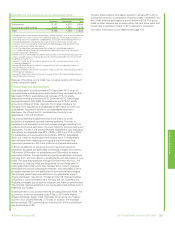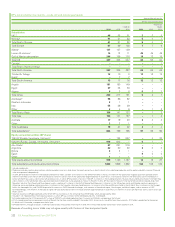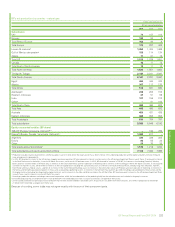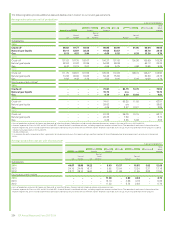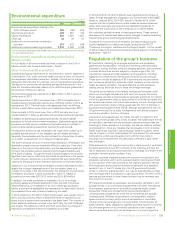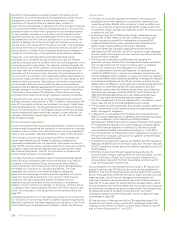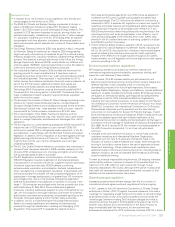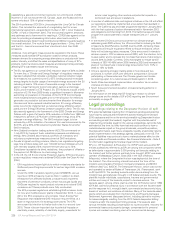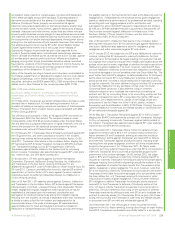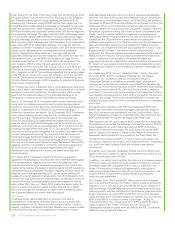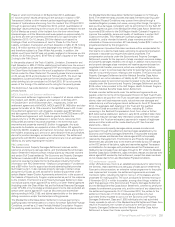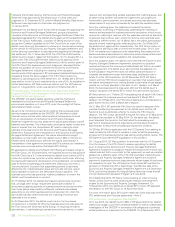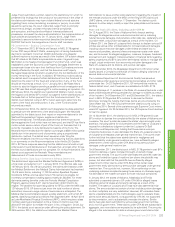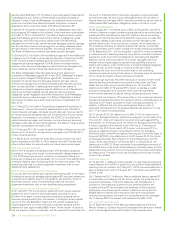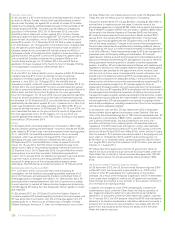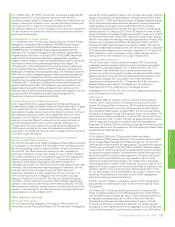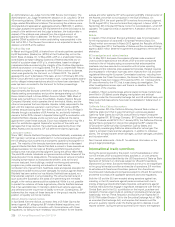BP 2014 Annual Report Download - page 235
Download and view the complete annual report
Please find page 235 of the 2014 BP annual report below. You can navigate through the pages in the report by either clicking on the pages listed below, or by using the keyword search tool below to find specific information within the annual report.
Phase 2, which commenced on 30 September 2013, addressed
(1) ‘source control’ issues pertaining to the conduct or inaction of BP,
Transocean Entities or other relevant parties regarding stopping the
release of hydrocarbons stemming from the Incident from 22 April 2010
through to approximately 19 September 2010, and (2) ‘quantification of
discharge’ issues pertaining to the amount of oil actually released into the
Gulf of Mexico as a result of the Incident from the time when these
releases began until the Macondo well was capped on approximately 15
July 2010 and then permanently cemented shut on approximately 19
September 2010. On 15 January 2015 the district court issued its
Findings of Fact and Conclusions of Law for Phase 2 of the Trial of
Liability, Limitation, Exoneration and Fault Allocation in MDL 2179, finding
that 3.19 million barrels of oil were discharged into the Gulf of Mexico
and therefore subject to a Clean Water Act penalty. In addition, the
district court found that BP was not grossly negligent in its source control
efforts. On 23 February 2015, BPXP filed a notice of appeal of the Phase
2 ruling to the Fifth Circuit.
In the penalty phase of the Trial of Liability, Limitation, Exoneration and
Fault Allocation in MDL 2179 the district court will determine the amount
of civil penalties to be assessed against BPXP and Anadarko arising under
the Clean Water Act based on the court’s application of the penalty
factors under the Clean Water Act. The penalty phase trial commenced
on 20 January 2015 and concluded on 2 February 2015. The court has
established a post-trial briefing schedule for the penalty phase under
which briefing is to be concluded on 24 April 2015. BP is not currently
aware of the timing of the district court’s ruling for the penalty phase.
The district court has wide discretion in the application of statutory
penalty factors.
MOEX, Anadarko and Cameron settlements
BP announced settlement agreements in respect of all claims related to
the Incident with MOEX, Anadarko and Cameron on 20 May 2011,
17 October 2011 and 16 December 2011, respectively. Under the
settlement agreement with MOEX, MOEX paid BP $1.065 billion and also
agreed to transfer all its 10% interest in the MC252 lease to BP. Under
the settlement agreement with Anadarko, Anadarko paid BP $4 billion
and also agreed to transfer all its 25% interest in the MC252 lease to BP.
The settlement agreement with Anadarko grants Anadarko the
opportunity for a 12.5% participation in certain future recoveries from
third parties and certain insurance proceeds in the event that such
recoveries and proceeds exceed $1.5 billion in aggregate. Any such
payments to Anadarko are capped at a total of $1 billion. BP agreed to
indemnify MOEX, Anadarko and Cameron for certain claims arising from
the Incident (excluding civil, criminal or administrative fines and penalties,
claims for punitive damages, and certain other claims). The settlement
agreements with MOEX, Anadarko and Cameron are not an admission of
liability by any party regarding the Incident.
PSC settlements
The Economic and Property Damages Settlement resolves certain
economic and property damage claims, and the Medical Benefits Class
Action Settlement resolves certain medical claims by response workers
and certain Gulf Coast residents. The Economic and Property Damages
Settlement includes a $2.3 billion BP commitment to help resolve
economic loss claims related to the Gulf seafood industry (for further
information see PSC Settlements – Seafood Compensation Fund below)
and a $57-million fund to support continued advertising that promotes
Gulf Coast tourism. It also resolves property damage in certain areas
along the Gulf Coast, as well as claims for additional payments under
certain Master Vessel Charter Agreements entered into in the course of
the Vessels of Opportunity Program implemented as part of the response
to the Incident. The Economic and Property Damages Settlement does
not include claims made against BP by the DoJ or other federal agencies
(including under the Clean Water Act and for Natural Resource Damages
under OPA 90) or by the states and local governments. Also excluded are
certain other claims against BP, such as securities and shareholder
claims pending in MDL 2185, and claims based solely on the deepwater
drilling moratorium and/or the related permitting process.
The Medical Benefits Class Action Settlement involves payments to
qualifying class members based on a matrix for certain Specified Physical
Conditions, as well as a 21-year Periodic Medical Consultation Program
for qualifying class members. The deadline for submitting claims under
the Medical Benefits Class Action Settlement passed on 12 February
2015. The settlement also provides that class members claiming Later-
Manifested Physical Conditions may pursue their claims through a
mediation/litigation process, but waive, among other things, the right to
seek punitive damages. Consistent with its commitment to the Gulf, BP
has also agreed as part of the Medical Benefits Class Action Settlement
to provide $105 million to the Gulf Region Health Outreach Program to
improve the availability, scope and quality of healthcare in certain Gulf
Coast communities. This healthcare outreach programme will be
available to, and is intended to benefit, class members and other
individuals in those communities. BP has already funded $79.1 million for
projects sponsored by this programme.
Each agreement provides that class members will be compensated for
their claims on a claims-made basis, according to agreed compensation
protocols in separate court-supervised claims processes. The
compensation protocols under the Economic and Property Damages
Settlement provide for the payment of class members’ economic losses
and property damages related to the oil spill. In addition many economic
and property damages class members will receive payments based on
negotiated risk transfer premiums, which are multiplication factors
designed, in part, to compensate claimants for potential future damages
that are not currently known, relating to the Incident. The Economic and
Property Damages Settlement and the Medical Benefits Class Action
Settlement are not an admission of liability by BP. The settlements are
uncapped except for economic loss claims related to the Gulf seafood
industry under the Economic and Property Damages Settlement and the
$105 million to be provided to the Gulf Region Health Outreach Program
under the Medical Benefits Class Action Settlement.
All class member settlements under the settlement agreements are
payable under the terms of the Deepwater Horizon Oil Spill Trust (Trust).
Other costs to be paid from the Trust include state and local government
claims, state and local response costs, natural resource damages and
related claims, and final judgments and settlements. As at 31 December
2014, the aggregate cash balances in the Trust and the qualified
settlement funds amounted to $5.1 billion, including $1.1 billion
remaining in the Seafood Compensation Fund, from which a further
$0.5 billion partial distribution started in early 2015, and $0.4 billion held
for natural resource damage early restoration projects. When the cash
balances in the Trust are exhausted, payments in respect of legitimate
claims and other costs will be made directly by BP. See Financial
statements – Note 2.
The economic and property damages claims process is under court
supervision through the settlement claims process established by the
Economic and Property Damages Settlement. This provides that class
members release and dismiss their claims against BP not expressly
reserved by that agreement. The Economic and Property Damages
Settlement also provides that, to the extent permitted by law, BP assigns
to the PSC certain of its claims, rights and recoveries against Transocean
and Halliburton for damages with protections such that Transocean and
Halliburton cannot pass those damages through to BP. Under the Medical
Benefits Class Action Settlement, class members release and dismiss their
claims against BP covered by that settlement, except that class members
do not release claims for Later-Manifested Physical Conditions.
PSC settlements – appeals
Under US federal law, there is an established procedure for determining
the fairness, reasonableness and adequacy of class action settlements.
Pursuant to this procedure, an extensive notice programme to the public
was implemented to explain the settlement agreements and class
members’ rights, including the right to ’opt out’ of the classes, and the
processes for making claims. The court conducted a fairness hearing on
8 November 2012 in which to consider, among other things, whether to
grant final approval of the Economic and Property Damages Settlement
and the Medical Benefits Class Action Settlement, whether to certify the
classes for settlement purposes only, and the merits of any objections to
the settlement agreements. On 21 November 2012, the parties to the
settlement filed a list of 13,123 individuals and entities who had
submitted timely requests to opt out of the Economic and Property
Damages Settlement Class and 1,638 individuals who had submitted
timely requests to opt out of the Medical Benefits Settlement Class. As a
result of revocations, the number of opt-outs for the Economic and
Property Damages Settlement and the Medical Benefits Class Action
Settlement is fewer than those reported figures.
Additional disclosures
BP Annual Report and Form 20-F 2014 231


